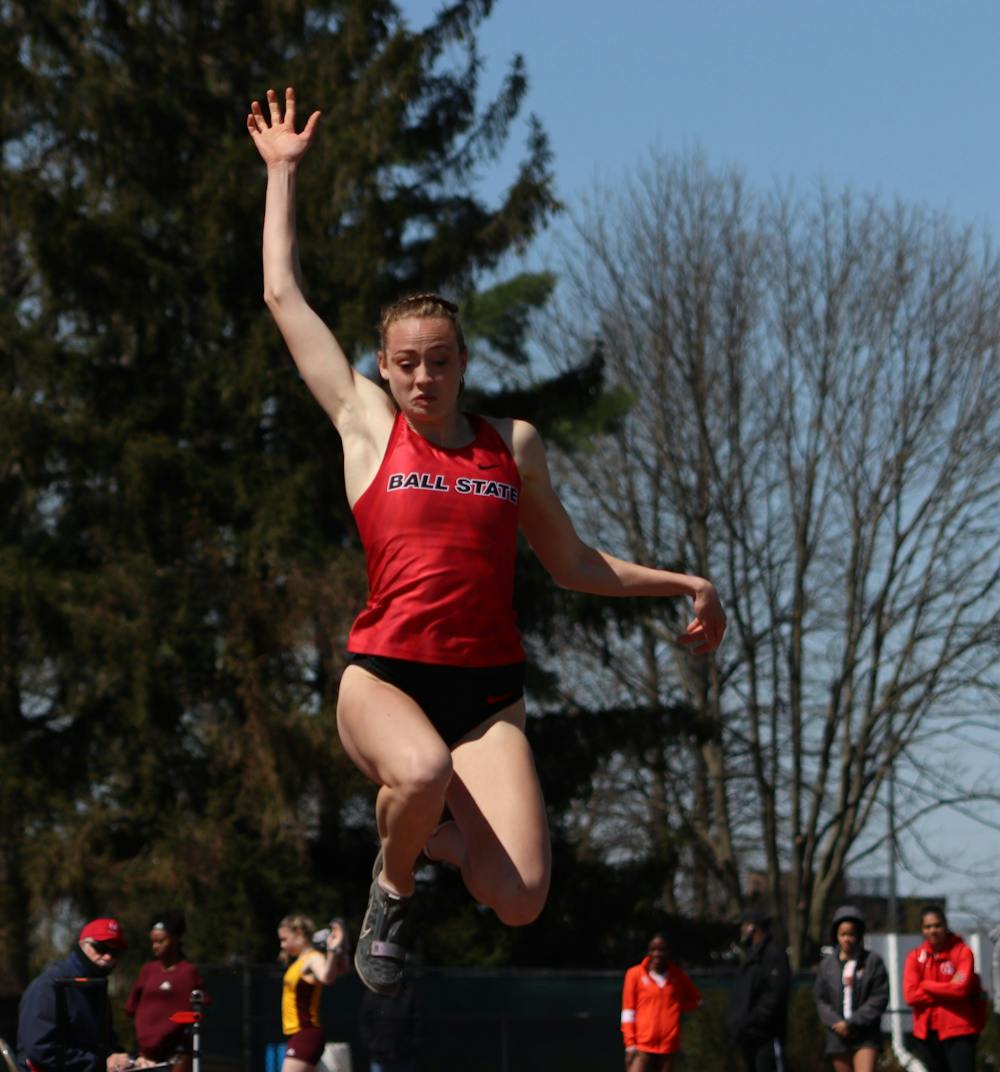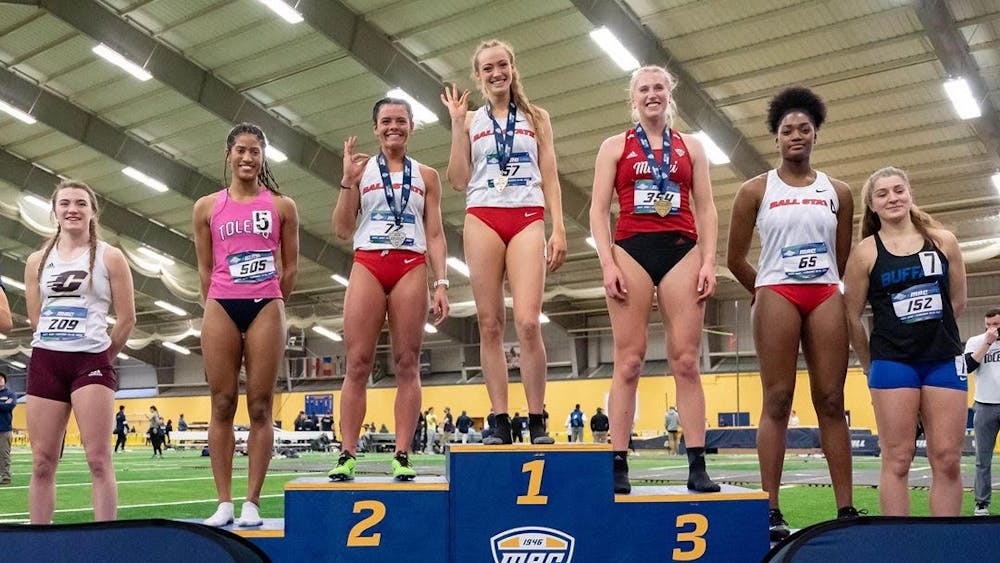For many, a torn meniscus means inactivity.
It may mean rehabilitation and rest.
Along with that, pessimism and doubt may creep in.
An injury can often bring a person to a low point in life, especially for an athlete who is used to competing at the highest level of their ability in their respective sport.
For Ball State Track & Field junior Charity Griffith, a torn meniscus doesn’t mean any of that.
Instead of pessimism and doubt, Griffith is still as optimistic as ever.
Instead of resting, Griffith is training for the NCAA Track & Field Championships in Eugene, Oregon, where she will compete June 11 at 2 p.m. (Pacific time) in the Women’s high jump final…with a torn meniscus.
“I honestly just give all credit to God that I can do it because it could have been so much worse…[this is] the best-case scenario for a torn meniscus,” Griffith said. “It doesn't hurt to walk on, it doesn't hurt to weight bear, it's not my jump leg, it could have gone so many different directions, but this is the direction that God chose for me.”
Griffith qualified for the NCAA Track & Field Championships in the high jump by clearing 6 (feet)-0.5 (inches) at NCAA Regionals in Bloomington, Indiana May 28…with a torn meniscus.
Ball State Track & Field assistant coach Holly Hankenson said she wanted to remind Griffith of how great of a job she did at Regionals, due to the high-stakes nature of her qualifying jump.
“We were sort of floating on cloud nine after that last jump just because we both knew just how close it was, really,” Hankinson said. “We kind of talked later like, ‘dude, that was the highest stakes jump of your life really.’ The scenario was, you make this bar you go into the National Meet, you don't make it you don't go, so it was really a higher pressure situation and she did a great job of handling it and executing on it.”
That said, Griffith doesn’t look at her accomplishments as more significant due to injury. Ball State Track & Field head coach Adrian Wheatley doesn’t either.
“She's one of those individuals that is like, ‘if I can do this, and I've got support from my coaching staff and our sports medicine, I'm gonna give it 100%’ and there was no wavering in that,” Wheatley said. “I know it sounds weird, but I'm not surprised because she has been very driven and focused. This is just a bump in the road and her body has allowed her to continue to do that, and she's just executed on that.”
Like Wheatley or Griffith herself, Hankenson wasn’t surprised at Griffith’s success either, although she said she may be “underrating” it.
Hankenson has developed a strong relationship with Griffith throughout the course of the indoor and outdoor season and feels her experience as a collegiate Track & Field athlete at the University of Arkansas and the University of Louisville has helped her relate to the athletes she coaches. She said her relatability to Griffith has helped keep a fun, yet competitive nature at practice.
“At the end of the day, this is hard. Track is hard. We train hard. Competing on a torn meniscus is hard,” Hankinson said. “So, if you can't have fun with it, keep it positive, keep it casual, it's really not worth it. So, I think being able to have fun and not take things too seriously at practice has been an important part of the longevity of the season too.”
Griffith said she is glad to have a strong bond with her coaching staff, as she hasn’t always had the same support in her athletic past as she does at Ball State.
“I feel like in my athletic career, there's always been a lot of doubt from other people,” Griffith said. “There is a lot of support here and it honestly helps tremendously knowing that people have the same hopes for you as you do for yourself.”
Her torn meniscus means she can no longer compete in the heptathlon as she normally does, however, Griffith has been training her upper body more often even in preparation for the high jump, since the injury limits her training of the lower body. Along with that, she has trained her mind more than before, as Griffith called the high jump a mental competition.

She said her assistant coaches, Hankenson and Angelina Ramos, have taught her the power of visualization in preparation for her competitions.
“I learned from Coach Holly and Coach Ramos that you use the same muscles neurologically, in visualization, as if you were actually doing the job,” Griffith said. “You use the exact same neural pathways in the brain as if you're actually jumping. So to train the mind as if you're actually jumping definitely helps so much more than what people would think…taking the time to visualize and train without putting any impact on my body.”
Griffith also talked about her faith and how it has helped her stay positive through her injury, and how her faith has continued to grow throughout her time at Ball State. She is a proud Christian and was baptized earlier in 2022.
Wheatley said he believes Griffith’s mix of faith, confidence and joy for the sport has aided her in finding success, despite the obstacles that have come her way in life and throughout her injury.
“I truly believe that those are characteristics that have helped her work her way through this process of a little bit of adversity and understanding that things happen for a reason,” Wheatley said. “We can pull on the support and faith of who we are and the skills that were given to us.”
Wheatley said as he has gotten to know Griffith over the course of the indoor and outdoor seasons, he has seen her optimism in all facets of life. With that, both Griffith and himself approached her injury in the same way.
“She views the world as opportunities, she's an individual where that is her default,” Wheatley said. “She is looking at everything as an opportunity and so when [the injury] presented itself, there were two ways to look at it; we're either going to sit here and cry over spilled milk or we're going to address it and figure out how to do it.”
Wheatley said Griffith’s “energy is contagious”, and her joy for the sport is not only fun to watch, but inspiring for him as a coach.
“At times we forget that it is fun to compete,” Wheatley said. “We talked with our team and our staff here like, just remember back in the day when we were at the playground in elementary school and we just wanted to beat people. We didn't ask how fast we were, we just wanted to be the fastest kid on the playground and Charity embraces that, she just wants to go out and compete.”
Griffith said she sets small goals for herself to conquer and continues to progress through her goals. She feels it is good to fail because it forces her to push herself towards eventual success.
Griffith accomplished one of her many goals during her indoor season, as she competed in the 2022 NCAA Indoor Track & Field Championships March 11-12 in Birmingham, Alabama. Hankenson said Griffith has “an intrinsic ability to compete” and said the 2021-22 year for Griffith has been one full of progress and accomplishments but knows she still has one more goal to reach.
“She's made tremendous, tremendous gains across all the events and as an athlete, but we talked about that it's just been a breakthrough year for her, so, we're not taking it for granted,” Hankinson said. “I don't think that some of these PRs [Personal Records] are going to come as easily next year or in the years following just because we're getting to the point where that's such a high level now, but it's been it's been a huge step forward and a huge breakthrough year for her and I'm excited for when the meet is over next week, we can really sit back and really reflect on that and kind of feel good about it, but for now, I think we're still sort of staying in the moment and being in kind of a competitive mindset and feeling like the job's not done yet.”
Griffith said she went into the NCAA Indoor Track & Field Championships excited but nervous. However, she feels in Eugene, she will go into the high jump final knowing she earned her spot and that she belongs among some of the NCAA’s best athletes.
“The first time I was very intimidated by a lot of the other people there, but it just took time for me to realize that I also belong there and that these people are just people like me,” Griffith said. “They trained to get where they're at and I think I just had to feel deserving of the spot to be there rather than nervous to be there.”
Yes, Griffith will compete June 11 with a torn meniscus, but if Griffith and her coaching staff’s words are anything to go by, chances are those in attendance or watching from home won’t see someone in pain or with a look of discouragement on their face, but someone with a smile ear to ear.
Contact Kyle Smedley with comments via email at kyle.smedley@bsu.edu or on Twitter @smedley1932.





